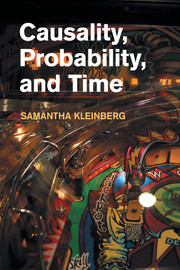8 - Conclusion
Published online by Cambridge University Press: 05 December 2012
Summary
At the core of many disciplines – including biomedicine, finance, and the social sciences – is the search for causes. To predict future events, understand the connection between phenomena, explain why things happen, and intervene to alter outcomes, researchers must determine the causal relationships governing the behavior of the systems they study. Automating this process has been a difficult pursuit for many reasons, from insufficient data and computing power to the more fundamental question of what causality is and how it can be inferred from observational data alone.
However, many of the previous barriers to inferring complex causal relationships are falling. Through technological advances enabling interrogation of the activities of single cells, the increasing adoption of electronic health records, and the prevalence of sites like Twitter that broadcast the thoughts and actions of millions of users, we now face a flood of data. As predicted by Moore's law, computers have also become faster and cheaper, making it possible to analyze this newly generated information. These datasets are too large for manual analysis, making automated inference not just a possibility, but a necessity. Medical doctors now have patients who log their own vital statistics and symptoms between visits and must integrate this data (that captures critical moments between appointments and admissions) with the patient's history and their own background knowledge. Stock traders are confronted with worldwide financial, political, and other events (reported at a rate far faster than one could read), and must extract the pertinent information and reconcile it with what is known about how markets behave in response to news.
- Type
- Chapter
- Information
- Causality, Probability, and Time , pp. 206 - 216Publisher: Cambridge University PressPrint publication year: 2012

